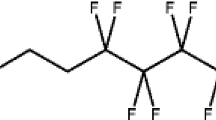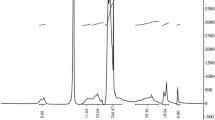Abstract
The microstructure of water soluble nanoaggregates based on polyelectrolyte complex formed by the cationic comb-type copolymer poly(acrylamide -co-[3- (methacryloyl-amino)propyl] trimethylammonium chloride)-graft- polyacrylamide [P(AM-co-MAPTAC)-g-PAM] and the anionic linear polyelectrolyte sodium polyacrylate (NaPA) was investigated using the fluorescence probe technique. The fluorescence probe were 1-anilinonaphthalene-8-sulfonic acid (ANS), pyrene (Py) and 1,10-bis(1-pyrene) decane (PD). The fluorescence properties in polyelectrolyte complex solutions, which are sensitive to either micropolarity (ANS, Py) or microviscosity (PD), were related to the quantities obtained in different pure or mixed solvents. Micropolarities were quantified utilizing the polarity common index (Reichardt) E T(30). ANS and Py showed a variation of the micropolarity with the charge ratio of the two polymers, with the lowest polarity reached at the complex neutralization. The PD probe, by its excimer-to-monomer fluorescence intensities ratio, enabled us to evidence the effect of the composition and the comb-type copolymer grafting density on the microviscosity of the interpolyelectrolytes aggregates. It has been found that the microviscosity increased with the density of the grafting PAM chains.




Similar content being viewed by others
References
Holmberg K, Jonsson B, Kronberg B, Lindman B (2002) Surfactants and polymers in aqueous solutions. Wiley, London
Kabanov VA, Zezin AB (1984) Soluble interpolymeric complexes as a class of synthetic polyelectrolytes. Pure Appl Chem 56:343–354
Kabanov AV, Bronich TK, Kabanov VA, Yu K, Eisenberg A (1996) Soluble stoichiometric complexes from poly(n-ethyl-4-vinylpyridinium) cations and poly(ethylene oxide)-block-polymethacrylate anions. Macromolecules 29:6797–6802
Philipp B, Dautzenberg H, Linow K-J, Kotz J, Dawydoff W (1989) Polyelectrolyte complexes—recent developments and open problems. Prog Polym Sci 14:91–172
Koetz K, Kosmella S (2007) Polyelectrolytes and nanoparticles. Springer, Berlin, p 36
Harada A, Kataoka K (1995) Formation of polyion complex micelles in an aqueous milieu from a pair of oppositely-charged block copolymers with poly(ethylene glycol) segments. Macromolecules 28:5294–5299
Gohy J-F, Varshney SK, Jerome R (2001) Water-soluble complexes formed by poly(2-vinylpyridinium)-block-poly(ethylene oxide) and poly(sodium methacrylate
Matralis A, Sotiropoulou M, Bokias G, Staikos G (2006) Water-soluble stoichiometric polyelectrolyte Complexes based on cationic comb-type copolymers. Macromol Chem Phys 207:1018–1025
Khutoryanskiy VV, Staikos G (2009) Hydrogen-bonded interpolymer complexes: formation, structure and applications. In: Khutoryanskiy VV, Staikos G (eds) World Sciencific.
Kabanov VA (1994) Physicochemical basis and the prospects of using soluble interpolyelectrolyte complexes (review). Polym Sci 56:143–156
Evans DF, Wennerstrom H (1999) The colloidal domain: where physics, chemistry, biology and technology meet, 2nd edn. Wiley-VCH, New York
Zana R (2000) Amphiphilic block copolymers. In: Alexandridis P, Lindman B (eds). Elsevier, pp 222–224.
Caldararu H, Caragheorgheopol A, Vasilescu M, Dragutan I, Lemmetyinen H (1994) Structure of the polar core in reverse micelles of nonionic poly(oxyetylene) surfactants, as studied by spin probe and fluorescence probe techniques. J Phys Chem 98(20):5320–5331
Vasilescu M, Caragheorgheopol A, Almgren M, Brown W, Alsins J, Johannsson R (1995) Structure and dynamics of nonionic polyoxyethylenic reverse micelles by time—resolved fluorescence quenching. Langmuir 11(8):2893–2898
Vasilescu M, Caragheorgheopol A, Caldararu H, Bandula R, Lemmetyinen H, Joela H (1998) Micropolarity and order in the reverse micelles of L62 and L64 pluronic copolymers, as studied by molecular probe techniques. J Phys Chem B 102(40):7740–7751
Vasilescu M, Caragheorgheopol A, Caldararu H (2001) Aggregation numbers and microstructure characterization of self-assembled aggregates of poly(ethylene oxide) surfactants and related block-copolymers, studied by spectroscopic methods. Adv Colloid Interface Sci 89–90:169–194
Bandula R, Vasilescu M, Lemmetyinen H (2005) Investigation of the micropolarity in reverse micelles of nonionic poly(ethylene oxide) surfactants using 4-nitropyridine- N- oxide as absorption probe. J Colloid Interface Sci 287(2):671–677
Vasilescu M, Bandula R, Lemmetyinen H (2010) Micropolarity and microviscosity of Pluronic L62 and L64 core-shell aggregates in water at various concentrations and additives examined by absorption and fluorescence probes. Colloid Polym Sci 288:1173–1184
Feitosa E, Brown W, Vasilescu M, Vethamuthu MS (1996) Effect of temperature on the interaction between the nonionic surfactant C12E5 and Poly(ethylene oxide) investigated by dynamic light scattering and fluorescence methods. Macromolecules 29(21):6837–6846
Vasilescu M, Anghel D, Almgren M, Hansson P, Saito S (1997) Fluorescence probe study of the interactions between nonionic poly(oxyethylenic) surfactants and poly(acrylic acid) in aqueous solutions. Langmuir 13(26):6951–6955
Vasilescu M, Angelescu D, Almgren M, Valstar A (1999) Interactions of globular proteins with surfactants studied with fluorescence probe methods. Langmuir 15(8):2635–2643
Ghiggino KP, Tan KL (1985) In: Philips D (ed) Polymer photophysics. Chapman & Hall, London.
Gasymov OK, Glasgow BJ (2007) ANS fluorescence: Potential to augment the identification of the external bonding sites of proteins. Biochim Biophys Acta 1774:403–411
Kosower EM, Kanety H (1983) Intramolecular Donor-Acceptor Systems. 10. Multiple fluorescence from 8-(phenylamino)-1-naphthalenesulfonates. J Am Chem Soc 105:6236–6243
Kosower EM, Huppert D (1986) Excited state electron and proton transfers. Ann Rev Phys Chem 37:127–156
DeToma RP, Easter JH, Brand L (1976) Dynamic interactions of fluorescence probes with the solvent environment. J Am Chem Soc 98:5001–5007
Brand L, Gohlke JR (1972) Fluorescence probes for structure. Ann Rev Biochem 41:843–868
Slavik I (1982) Anilinonaphthalene sulfonate as a probe of membrane composition and function. Biochim Biophys Acta 694:1–25
Creighton TE (1992) In: Freeman WH (ed) Protein folding. New York, pp 284–285.
Matulis D, Baumann C, Bloomfield V, Lovrien R (1999) 1-Anilino-8-naphthalene sulfonate as a protein conformational tightening agent. Biopolymers 49:451–458
Robinson GW, Robbins RJ, Morris JM, Knight AE, Morrison RJS (1978) Picosecond studies of the fluorescence probe molecule 8-anilino-1-naphthalenesulfonic acid. J Am Chem Soc 100(23):7145–7150
Upadhyay A, Bhatt T, Tripathi HB, Pant DD (1995) Photophysics of 8- anilinonaphthalene −1-sulphonate. J Photochem Photobiol A: Chem 89:201–207
Dimroth K, Reichardt C, Schweig A (1963) Uber die thermochromie von pyridinium- N- phenol betaine. Liebigs Ann Chem 669:95–105: Reichardt C (1965) Empirical parameters of the polarity of solvents. Angew Chem Int Ed 4(1):29–40.
Kalyanasundaram K, Thomas JK (1977) Environmental effects on vibronic band intensities in pyrene monomer fluorescence and their application in studies of micellar systems. J Am Chem Soc 99:2039–2044
Dong DC, Winnik MA (1982) The Py scale of solvent polarity. Solvent effects on the vibronic fine structure of pyrene fluorescence and empirical correlations with ET and Y values. Photochem Photobiol 35(1):17–21
Winnik FM, Regismond STA (1996) Fluorescence methods in the study of the interactions of surfactants with polymers. Colloid Surf A: Physicochem Eng Aspect 118:1–39
Zahariasse KA (1978) Intramolecular excimer formation with diarylalkanes as a microfluidity probe for sodium dodecyl sulphate micelles. Chem Phys Lett 57(2):429
Angelescu DG, Vasilescu M, Staikos G (2011) Characterization of the water-soluble comb-linear interpolyelectrolyte nanoaggregates by Monte Carlo simulations and fluorescence probe techniques. Colloid Polym Sci 289:871–879
Acknowledgments
Financial support from the National University Research Council—Executive Agency for Higher Education and Research Funding (CNCSIS) PN 2 IDEI project code1317 is gratefully acknowledged.
Author information
Authors and Affiliations
Corresponding author
Rights and permissions
About this article
Cite this article
Vasilescu, M., Angelescu, D.G., Bandula, R. et al. Microstructure of Polyelectrolyte Nanoaggregates Studied by Fluorescence Probe Method. J Fluoresc 21, 2085–2091 (2011). https://doi.org/10.1007/s10895-011-0907-2
Received:
Accepted:
Published:
Issue Date:
DOI: https://doi.org/10.1007/s10895-011-0907-2




